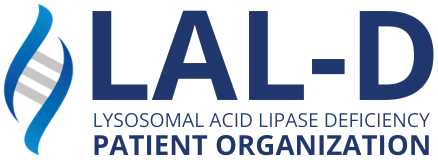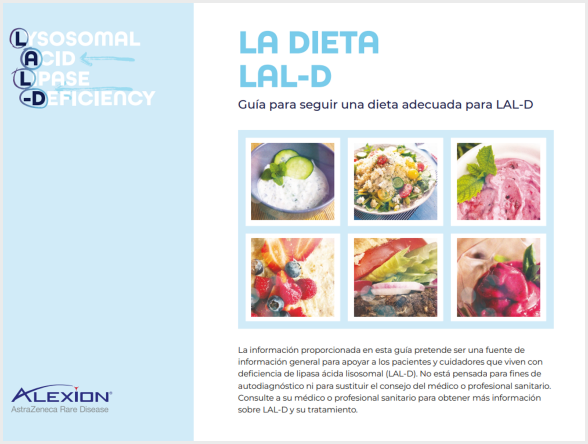WHAT IS LAL-D?
Lysosomal Acid Lipase Deficiency (LAL-D) is a rare, inherited, and progressive genetic disorder caused by mutations in the LIPA gene, which result in the absence or deficiency of the enzyme lysosomal acid lipase (LAL).
This enzyme is essential for metabolizing fats and cholesterol within cells. Without it, cholesterol esters and triglycerides accumulate in the liver, spleen, intestine, and blood vessels, progressively damaging the body.
CLINICAL FORMS:
Wolman Disease
(Severe, rapid-onset infantile form)
It appears within the first months of life with persistent diarrhea, abdominal distension (hepatosplenomegaly), vomiting, growth retardation, anemia, and calcifications in the adrenal glands. Without proper nutrition and treatment, it often has fatal consequences before the first year of life.
Cholesteryl Ester Storage Disease (CESD)
(Late infantile, juvenile, or adult forms)
This form generally progresses more slowly than Wolman disease, with variable severity depending on the patient. It presents with progressive liver involvement (fatty liver, fibrosis/cirrhosis, and risk of liver failure) and significant lipid abnormalities (elevated LDL, low HDL, and sometimes elevated triglycerides), increasing the risk of cardiovascular disease (heart attack or stroke) at an early age.
Both forms are manifestations of the same disorder, differing in severity according to the level of enzyme activity.
DIAGNOSIS
Lysosomal Acid Lipase Deficiency (LAL-D) is confirmed by a dried blood spot (DBS) enzyme assay, which measures LAL enzyme activity.
Genetic testing of the LIPA gene identifies the causative mutations, confirming the diagnosis and enabling genetic counseling for families.
Early diagnosis is essential: the sooner it is detected, the sooner treatment can begin—significantly improving prognosis and quality of life.
TREATMENT
Since 2015, a specific treatment has been available: enzyme replacement therapy (ERT), which replaces the missing enzyme. It can save lives in severe cases and improve outcomes in patients of all ages. It is administered intravenously every one or two weeks.
The earlier treatment is started, the better the results—hence the importance of early diagnosis and newborn screening.
In addition, medical follow-up includes monitoring liver function, lipid profile, and providing specialized nutritional support.
DIFFERENTIAL DIAGNOSIS
Differential diagnosis is essential to identify lysosomal acid lipase deficiency (LAL-D) and distinguish it from other conditions with similar symptoms, such as metabolic or liver diseases. An accurate evaluation allows for the initiation of appropriate treatment and improves patient prognosis.
Reference:
de las Heras, J.; Almohalla, C.; Blasco-Alonso, J.; Bourbon, M.; Couce, M.-L.; de Castro López, M.J.; García Jiménez, M.C.; Gil Ortega, D.; González-Diéguez, L.; Meavilla, S.; et al. Practical Recommendations for the Diagnosis and Management of Lysosomal Acid Lipase Deficiency with a Focus on Wolman Disease. Nutrients 2024, 16, 4309. https://doi.org/10.3390/nu16244309
LAL-D Cookbook
Learn more about LAL-D on the LAL-D Your Way website, where you’ll find additional information about Lysosomal Acid Lipase Deficiency (LAL-D).
You can also access the LAL-D Cookbook, specially designed for people living with LAL-D and their families.
Managing LAL-D can seem overwhelming, but with proper nutrition, you can take an active step toward a healthier lifestyle.
The cookbook offers delicious and easy recipes, tailored to specific dietary needs and created by healthcare professionals.
Download it and discover new recipes!
ORPHA:275761
Lysosomal acid lipase deficiency
Prevalence: 1-9 / 100 000
Inheritance: Autosomal recessive
Age of onset: Adolescent, Adult, Childhood, Infancy, Neonatal
ORPHA:75233
Wolman disease
Prevalence: Unknown
Inheritance: Autosomal recessive
Age of onset: Infancy, Neonatal
ICD-10: E75.5
ICD-11: 5C56.0Y
OMIM: 278000
UMLS: C0043208
MeSH: D015223
GARD: 7899
MedDRA: 10053687
ORPHA:75234
Cholesteryl ester storage disease
Synonym(s): Cholesterol ester storage disease
Prevalence: Unknown
Inheritance: Autosomal recessive
Age of onset: Adolescent, Adult, Childhood
ICD-10: E75.5
ICD-11: 5C56.0Y
OMIM: 278000
UMLS: C0008384
MeSH: D015217
GARD: 12099






